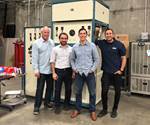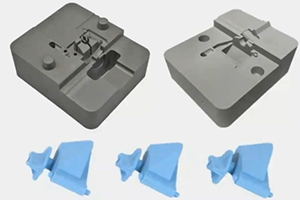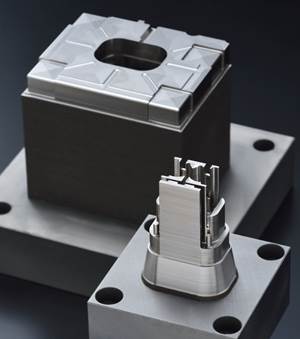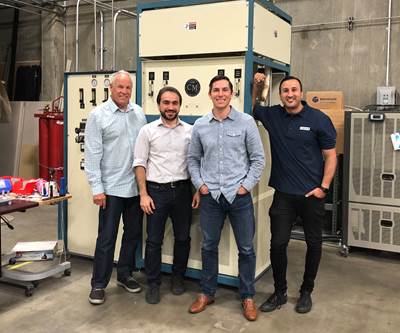3DEO’s Intelligent Layering process is similar to binder jetting and other sinter-based additive manufacturing technologies with a few differences. First, the powdered metal used is finer than that typically applied in binder jetting. Second, with Intelligent Layering binder is applied to all the powder in the layer, not just that intended for the final parts. Finally, the geometry of each part is achieved not through the 3D printing mechanism but through milling layers of material at controllable intervals. Post-printing, parts are sintered in a furnace and then may be machined or further postprocessed before use.
3DEO developed Intelligent Layering and applies this proprietary technique to provide parts for its own customers. Along with developing its Saffron 3D printers, the company is also working to improve and automate various steps in the workflow including depowdering, sintering preparation and inspection.
While the company previously focused on winning work otherwise destined for metal injection molding, machining or casting, more recently it has pivoted toward an approach that emphasizes design for additive manufacturing (DFAM) and more holistic problem solving. Read more in this related article.
Transcript
0:00 – 0:11
Metal 3D printing, like you've probably never seen it before. I'm Stephanie Hendrixson with Additive Manufacturing Media. I'm here in Torrance, California, at 3DEO’s facility, standing in front of one of their Saffron 3D printers.
0:12 – 0:20
This is a machine that uses a process that's similar to binder jetting, but it's one that 3DEO developed all internally, and they call it Intelligent Layering.
0:21 – 0:39
So inside of this machine, the printer is spreading a thin layer of metal powder. They use MIM powders, which are a little bit smaller a little bit finer than you might find in typical binder jetting. The machine is jetting binder over the entire layer at once. So all of the powder is getting coated with a very, very thin layer of the binding agent.
0:40 – 0:56
And then there is a head that comes in with eight different cutting tools which can be run simultaneously or individually. And those tools are cutting the geometry of the parts that are being made. They're also doing a little bit of extra machining work. They are cutting features that are going to allow for the parts to be broken out of the powder cake later.
0:57 – 1:11
So once all of the layers have been built up, the entire build comes out as one solid cake. The parts get broken out of that excess powder, they get to de-powdered and then they go through a sintering step to achieve their final part properties.
1:12 – 1:34
3DEO is finding that it often makes more sense to look at the complete subassembly that a part is going into and work to redesign and change maybe multiple parts at once rather than just 3D printing individual pieces. They are also getting into a lot of assembly themselves where they might be making several parts for a single customer and then also putting them together here in-house.
1:35 – 1:56
They're looking for ways to add additional value to the parts that they’re producing here. This process also has some advantages versus other types of metal binder jetting type processes. For one, that finer powder leads to finer surface finishes, which means there might be less post-processing later. You might have fewer process steps overall.
1:57 – 2:04
And 3DEO is working towards a more automated manufacturing process. They want to go into serial production. They want to be making lots of parts.
2:05 – 2:15
And so they're looking at things like how to teach robots more easily to de-powder these parts, to process these parts, to pick and place them and prepare them for the sintering furnace.
2:16 – 2:21
These machines, meanwhile, are still under development. That's one of the advantages of developing and operating your own 3D printing technology.
2:23 – 2:41
You can continue to iterate, continue to make them better, but the vision is that someday soon customers will be able to take these machines in-house and do Intelligent Layering in their own facilities as well.
Related Content
Nicolet Plastics Succeeds Using Mantle's Hybrid Metal 3D Printing Method for Mold Tooling
A recent webinar explores Nicolet Plastics’ success using Trueshape Technology, Mantle’s approach to print injection mold tooling. The current challenges this technology addresses and alleviates in additive manufacturing confirms this method is effectively reducing lead times and cost constraints, while producing better inserts.
Read MoreHybrid Metal 3D Printer Enables Quick-turn Prototyping
IMTS: Matsuura Machinery’s Lumex Avance hybrid metal 3D printers are said to enable lights-out production for highly accurate parts from metal powders.
Read More5 Points You Might Not Know About Hybrid CNC Machine Tools
Hybrid Manufacturing Technologies’ co-founder describes the role of hybrid additive manufacturing machines, and explores their possibilities related to heat treating, multimaterial tooling and making parts with embedding sensing.
Read MoreLarge-Format “Cold” 3D Printing With Polypropylene and Polyethylene
Israeli startup Largix has developed a production solution that can 3D print PP and PE without melting them. Its first test? Custom tanks for chemical storage.
Read MoreRead Next
3DEO’s Strategy to Perfect and Scale Metal AM
With a fast, flexible and increasingly automated process for metal additive manufacturing, 3DEO believes it’s cracking the code for volume production.
Read More3DEO Adds Design for Additive Manufacturing as Core Service
IMTS 2022: New offering opens 3DEO’s technology to customers across all stages of product development.
Read MoreAt General Atomics, Do Unmanned Aerial Systems Reveal the Future of Aircraft Manufacturing?
The maker of the Predator and SkyGuardian remote aircraft can implement additive manufacturing more rapidly and widely than the makers of other types of planes. The role of 3D printing in current and future UAS components hints at how far AM can go to save cost and time in aircraft production and design.
Read More

.jpg;width=70;height=70;mode=crop)










.png;maxWidth=300;quality=90)











